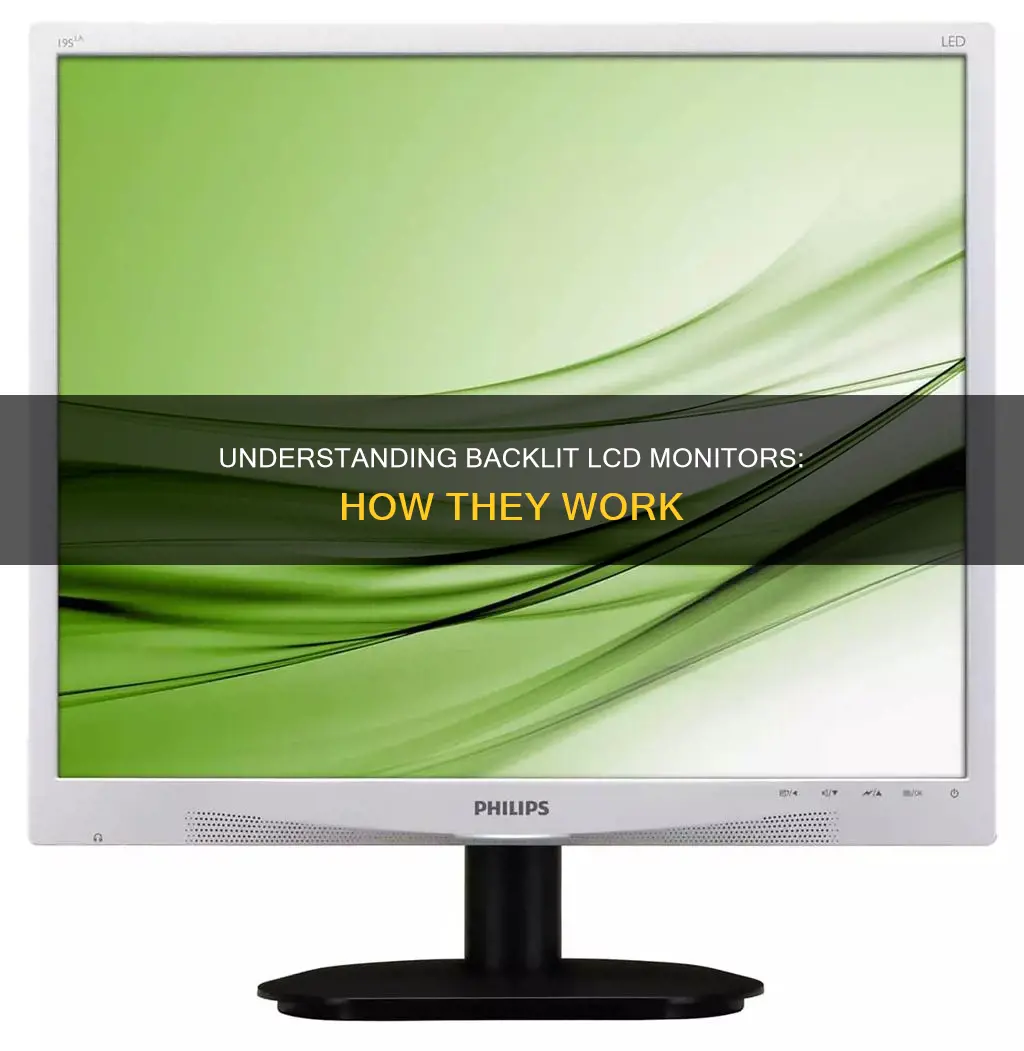
LED-backlit LCD monitors are a type of Liquid Crystal Display (LCD) monitor that uses Light Emitting Diodes (LEDs) for backlighting instead of traditional cold cathode fluorescent (CCFL) backlighting. LCD monitors use liquid crystals, which have properties of both liquids and solids, to create images on a screen. When an electric current is applied, the liquid crystals align to allow or block light, creating the images you see on the display. LED-backlit LCDs are now the leading display technology for high-definition TVs, as well as smartphones and other mobile electronic devices.
| Characteristics | Values |
|---|---|
| Display technology | LED-backlit LCD is the leading display technology for high-definition TVs, smartphones, and other mobile electronic devices. |
| Backlighting | LED-backlit LCDs use light-emitting diodes (LEDs) for backlighting instead of traditional cold cathode fluorescent lamps (CCFLs). |
| Image quality | LED-backlit LCDs offer superior picture quality with better contrast ratios and improved visual clarity. |
| Color accuracy | LED-backlit LCDs offer a wider color gamut and better color accuracy. |
| Energy efficiency | LED-backlit LCDs are more energy-efficient, consuming 20-30% less power than traditional LCD monitors. |
| Lifespan | LED-backlit LCDs have a longer lifespan due to their more durable backlighting technology. |
| Thickness | LED-backlit LCDs are thinner, with some screens less than 0.5 inches (13 mm) thin in edge-lit panels. |
| Weight | LED-backlit LCDs weigh less, making them easier to handle and carry. |
| Maintenance | LED-backlit LCDs have easier maintenance. |
What You'll Learn

LED vs CCFL backlighting
LED (Light-Emitting Diode) and CCFL (Cold Cathode Fluorescent Lamp) are two types of backlighting for LCD screens. While LED backlighting is now the most common, CCFL was the traditional method of backlighting for LCD screens.
Advantages of LED Backlighting
- Longer Lifespan: LED backlights have a longer lifespan than CCFL, with estimates ranging from 60,000 to 100,000 hours.
- No Inverter Required: LED backlights operate on DC power, so there is no need for an inverter, and they don't produce noise that can interfere with external circuits.
- Lower Power Consumption: LED backlights typically consume 20-30% less power than CCFL backlights, resulting in energy savings and potentially longer battery life for mobile devices.
- Lighter and Cooler: LED backlights are significantly lighter and generate less heat than CCFL backlights, making them ideal for mobile devices and reducing the weight of TVs.
- Slimmer Design: LED-backlit LCD screens can be very slim, with some screens less than 0.5 inches (13 mm) thin.
- Wider Color Gamut: LED backlights offer a wider range of colours, resulting in more vibrant and accurate images.
- Greater Contrast Ratio: LED backlights provide a higher contrast ratio, improving the overall image quality.
- Mercury-Free: Unlike CCFL backlights, LED backlights do not contain mercury, which is an environmental pollutant.
- Faster Response Time: LEDs have a faster on and off response time, making them suitable for displaying fast-moving images without motion blur.
- Cold Temperature Operation: LED backlights can operate at extreme cold temperatures, making them suitable for use in cold environments.
Disadvantages of LED Backlighting
- Uneven Lighting on Larger Displays: LED backlights may not provide as even light distribution as CCFL on larger displays, resulting in hot and cold spots. However, this can be mitigated by using a diffuser.
- Thicker Displays: In some cases, LED-backlit displays may be thicker than their CCFL counterparts.
Advantages of CCFL Backlighting
- Even Lighting: CCFL backlights provide a more even light distribution, especially on larger displays, resulting in a consistent image quality across the screen.
- Less Heat: In some cases, CCFL backlights may generate less heat than LED backlights, although this advantage is diminishing as LED technology improves.
Disadvantages of CCFL Backlighting
- Shorter Lifespan: CCFL backlights have a shorter lifespan than LED, with an estimated lifespan of 20,000 to 30,000 hours.
- Higher Voltage Requirement: CCFL backlights require a higher voltage to operate, which can be a disadvantage in terms of power efficiency.
- Inverter Requirement: CCFL backlights require an inverter to operate, which can add complexity and cost to the display design.
- Mercury Content: CCFL backlights
Cited Documents: 0,2,3,4,5LED vs CCFL backlighting has been a topic of discussion as the display market transitions from CCFL (cold cathode fluorescent lamp) to LED (light-emitting diode) backlighting. While LED backlighting is considered greener, with lower power consumption, longer lifespans, and no mercury, there are some potential drawbacks. Here is a detailed comparison between the two:
LED Backlighting
LED backlighting offers several advantages over CCFL:
- Longer Lifespan: LED backlights are estimated to last 60,000 to 100,000 hours, significantly longer than CCFL's 20,000 to 30,000 hours.
- Lower Power Consumption: LED backlights typically consume 20-30% less power than CCFL, contributing to energy savings and reduced environmental impact.
- Lightweight and Slim Design: LED-backlit LCDs are significantly lighter and slimmer, making them ideal for manufacturing lighter and more compact devices like smartphones and TVs.
- Wider Color Gamut: LED backlighting offers a wider range of colours, enhancing the viewing experience with more vibrant and accurate colours.
- Greater Contrast Ratio: LED backlights provide a higher contrast ratio, resulting in deeper blacks and brighter whites, improving the overall image quality.
- Mercury-Free: Unlike CCFL, LED backlights do not contain mercury, which is an environmental pollutant.
- Faster Response Time: LEDs have a faster on and off response time, making them suitable for displaying fast-moving images without motion blur.
- Cold Temperature Operation: LED backlights can operate at extreme cold temperatures, making them versatile for use in various environments.
However, LED backlighting also has some disadvantages:
- Uneven Lighting on Larger Displays: On larger screens, LED backlights may result in uneven lighting, with visible hot and cold spots. This issue can be mitigated with the use of a diffuser.
- Potential Eye Strain: Some people experience eye strain and headaches from LED backlights due to the use of PWM (pulse-width modulation) dimming, which causes a strobing effect.
- Cost: LED backlights can be more expensive than CCFL, although prices have dropped over time.
CCFL Backlighting
CCFL backlighting, while an older technology, still offers some benefits:
- Even Lighting: CCFL backlights provide more uniform lighting across larger displays, resulting in a consistent and smooth image without noticeable hotspots.
- Less Heat: In some cases, CCFL backlights generate less heat than LED backlights, although this advantage is diminishing as LED technology advances.
However, CCFL backlighting also has its drawbacks:
- Shorter Lifespan: CCFL backlights have a shorter lifespan than LED, requiring more frequent replacements.
- Higher Voltage Requirement: CCFL backlights need a higher voltage to operate, which can be a disadvantage in terms of energy efficiency.
- Use of Mercury: CCFL backlights contain mercury, which is toxic and harmful to the environment, leading to restrictions and bans in many countries.
- Slower Response Time: CCFL backlights have a slower response time, which may result in motion blur for fast-moving images.
- Bulkier Design: CCFL backlights are generally bulkier and heavier than LED backlights, making them less suitable for slim and lightweight devices.
In summary, LED backlighting offers improvements in power efficiency, lifespan, colour reproduction, and design flexibility. However, CCFL backlighting still has its advantages, particularly in providing even lighting on larger displays and generating less heat in some cases. The choice between the two depends on specific requirements, with LED being the more popular and environmentally friendly option in modern displays.LED vs CCFL backlighting has been a topic of discussion as the display market transitions from CCFL (cold cathode fluorescent lamp) to LED (light-emitting diode) backlighting. While LED backlighting is considered greener, with lower power consumption, longer lifespans, and no mercury, there are some potential drawbacks. Here is a detailed comparison between the two:
LED Backlighting
LED backlighting offers several advantages over CCFL:
- Longer Lifespan: LED backlights are estimated to last 60,000 to 100,000 hours, significantly longer than CCFL's 20,000 to 30,000 hours.
- Lower Power Consumption: LED backlights typically consume 20-30% less power than CCFL, contributing to energy savings and reduced environmental impact.
- Lightweight and Slim Design: LED-backlit LCDs are significantly lighter and slimmer, making them ideal for manufacturing lighter and more compact devices like smartphones and TVs.
- Wider Color Gamut: LED backlighting offers a wider range of colours, enhancing the viewing experience with more vibrant and accurate colours.
- Greater Contrast Ratio: LED backlights provide a higher contrast ratio, resulting in deeper blacks and brighter whites, improving the overall image quality.
- Mercury-Free: Unlike CCFL, LED backlights do not contain mercury, which is an environmental pollutant.
- Faster Response Time: LEDs have a faster on and off response time, making them suitable for displaying fast-moving images without motion blur.
- Cold Temperature Operation: LED backlights can operate at extreme cold temperatures, making them versatile for use in various environments.
However, LED backlighting also has some disadvantages:
- Uneven Lighting on Larger Displays: On larger screens, LED backlights may result in uneven lighting, with visible hot and cold spots. This issue can be mitigated with the use of a diffuser.
- Potential Eye Strain: Some people experience eye strain and headaches from LED backlights due to the use of PWM (pulse-width modulation) dimming, which causes a strobing effect.
- Cost: LED backlights can be more expensive than CCFL, although prices have dropped over time.
CCFL Backlighting
CCFL backlighting, while an older technology, still offers some benefits:
Even Lighting: CCFL backlights provide
Secretly Monitoring iPhone Usage: A Step-by-Step Guide
You may want to see also

LCD monitors explained
LCD stands for Liquid Crystal Display. This technology uses liquid crystals, which are substances with properties of both liquids and solids. When an electric current is applied, the liquid crystals align to allow or block light, creating the images you see on the display. LCD monitors use cold cathode fluorescent lamps (CCFLs) for backlighting.
LCD monitors are flat-panel displays that use liquid crystal technology to produce images. They control the passage of light using liquid crystals and illuminate the screen with a backlight, usually a CCFL. LCDs have good colour reproduction and brightness and are typically thinner and more energy-efficient than older CRT monitors.
LED-backlit LCDs are liquid crystal displays (LCDs) with a light-emitting diode (LED) backlight. All LCDs require a backlight to illuminate their liquid crystals and produce visual images. While there are several types of backlights available, LED is the most common. LED-backlit LCDs use the same TFT LCD (thin-film-transistor liquid-crystal display) technologies as CCFL-backlit LCDs but offer several advantages.
Benefits of LED-Backlit LCDs
LED-backlit LCDs offer a wider colour gamut, greater contrast ratios, and are significantly lighter and cooler than CCFL-backlit LCDs. They also consume less power and have a longer lifespan. LED-backlit LCDs are ideal for TVs, smartphones, and other mobile electronic devices as they allow manufacturers to build lighter products that are easier to handle and carry.
Types of LED Backlighting
LED-backlit LCDs use two main types of backlighting: full-array backlighting and edge lighting. In full-array backlighting, LEDs are placed evenly across the entire screen, allowing for local dimming and better contrast. In edge lighting, LEDs are placed along the edges of the screen, resulting in thinner displays but potentially less uniform lighting.
LED vs LCD
When shopping for a monitor, you may encounter the terms LCD and LED. It's important to note that all LED monitors are a type of LCD monitor, with LED standing for LED-backlit LCD monitor. LED monitors offer superior picture quality with better contrast ratios and improved colour accuracy and visual clarity. They are also thinner, more energy-efficient, and have a longer lifespan than standard LCD monitors. However, LCD monitors are generally more affordable and offer the advantage of matte screens, which reduce glare in bright environments.
Boosting Volume on Your ASUS Monitor: Easy Tips and Tricks
You may want to see also

LED monitors explained
LED monitors are a type of LCD (liquid crystal display) monitor that uses light-emitting diodes (LEDs) for backlighting instead of traditional cold cathode fluorescent (CCFL) backlighting. All LCDs require a backlight to illuminate their liquid crystals and produce visual images.
LED-backlit LCDs use the same TFT LCD (thin-film-transistor liquid-crystal display) technologies as CCFL-backlit LCDs, but with several advantages. LED backlights can be arranged in two ways:
- Edge lighting: LEDs are placed along the perimeter of the screen, providing even illumination through a diffusion pattern.
- Full-array backlighting: LEDs are placed evenly across the entire screen, allowing for local dimming and better contrast.
Benefits of LED Monitors
LED monitors offer several benefits over traditional LCD monitors:
- Superior picture quality: LED monitors have better contrast ratios and colour accuracy, producing deeper blacks and a wider colour gamut.
- Thinner and lighter design: LED backlighting allows for slimmer screens, making devices easier to handle and carry.
- Lower power consumption: LED monitors are more energy-efficient, consuming 20-30% less power than LCD monitors, which can lead to lower electricity bills.
- Longer lifespan: LED backlights have a longer lifespan of 50,000 to 100,000 hours compared to 30,000 to 60,000 hours for CCFL backlights.
- Faster response times: LED monitors have faster response times, reducing motion blur and ghosting, making them ideal for gaming.
- Wider viewing angles: LED monitors, especially those using IPS technology, offer wider viewing angles, maintaining consistent colours and contrast when viewed from different angles.
Limitations of LED Monitors
Despite their advantages, LED monitors also have some limitations:
- Higher cost: LED monitors are generally more expensive than LCD monitors, although the price gap has narrowed in recent years.
- Inconsistent lighting: Edge-lit LED monitors may have less uniform lighting across the screen, causing darker images to appear washed out. Full-array LED monitors provide more consistent lighting.
- Blue light emission: LED monitors may emit more blue light, which can cause eye strain, although newer models often include blue light filtering options.
Applications of LED Monitors
LED-backlit LCDs have become the leading display technology for high-definition TVs, smartphones, and other mobile devices. They are also commonly used in computer monitors, digital billboards, vehicle infotainment systems, and more.
Monitoring Energy Usage: Sub-Panel Edition
You may want to see also

LED backlighting explained
LED-backlit LCDs are liquid crystal displays (LCDs) with a light-emitting diode (LED) backlight. All LCDs require a backlight to illuminate their liquid crystals and produce visual images. Without a backlight, an LCD cannot produce a clear, visible image.
LED-backlit LCDs use the same TFT LCD (thin-film-transistor liquid-crystal display) technologies as CCFL-backlit LCDs but offer a variety of advantages. These include a wider colour gamut, greater contrast ratio, lighter weight, lower power consumption, and longer lifespan.
In a typical LED-backlit LCD, the individual LED bulbs are arranged in one of two ways. The first option is to place the LED bulbs in a perimeter around the edge of the display in a diffusion pattern. This evenly distributes the light to provide even illumination throughout the device’s liquid crystals. The second option is to arrange the LED bulbs behind the screen at evenly spaced distances. This arrangement also provides an even distribution of light, thereby offering bright, clear images.
The LEDs in "LED TVs" come in several different configurations, and the arrangement of the LED backlights can have a dramatic effect on picture quality. Most LED LCDs on the market today are edge-lit, which means the LEDs are on the sides of the TV, facing in towards the screen. There are also models that have their LEDs arrayed on the back of the TV, facing the viewer.
The biggest difference between all the LED back/edge-lighting methods is how effective their "local dimming" is. Local dimming allows for dynamic control of the level of light intensity in specific areas of the screen, resulting in higher contrast ratios. However, this can come at the cost of less detail in small, bright objects on a dark background, such as stars in a night sky.
Setting Up the ProArt 248Q: A Step-by-Step Guide
You may want to see also

LED-backlit LCDs in TVs, monitors, and displays
LED-backlit LCDs are liquid crystal displays (LCDs) with a light-emitting diode (LED) backlight. All LCDs require a backlight to illuminate their liquid crystals and produce visual images. Without a backlight, an LCD cannot produce a clear, visible image.
LED-backlit LCDs use the same TFT LCD (thin-film-transistor liquid-crystal display) technologies as CCFL-backlit LCDs but offer several advantages over them. These include a wider colour gamut, a greater contrast ratio, a slim design, lower power consumption, and a longer lifespan.
In a typical LED-backlit LCD, the individual LED bulbs are arranged in one of two ways. The first option is to place the LED bulbs in a perimeter around the edge of the display in a diffusion pattern. This evenly distributes the light to provide even illumination throughout the device’s liquid crystals. The second option is to arrange the LED bulbs behind the screen at evenly spaced distances. This arrangement also provides an even distribution of light, thereby offering bright, clear images.
Televisions that use a combination of an LED backlight with an LCD panel are sometimes advertised as LED TVs, although they are not truly LED displays. They are better described as a sub-set of LCD devices.
LED-backlit LCDs are used in TVs, monitors, and displays in many different places, including ATMs, cash registers, digital billboards, fitness equipment, vehicle infotainment systems, gas station pumps, and mobile devices.
Asus Monitor Power Cord Size: What You Need to Know
You may want to see also
Frequently asked questions
A backlit LCD monitor is a liquid crystal display (LCD) with a light-emitting diode (LED) backlight. LCDs require a backlight to illuminate their liquid crystals and produce visual images. LED backlights are placed either along the edges of the screen or across the entire screen.
A backlit LCD monitor offers several benefits, including:
- Superior picture quality with better contrast ratios and improved visual clarity.
- Wider color gamut, producing more colours.
- Lower power consumption and longer lifespan.
- Thinner and lighter form factor.
Some drawbacks of a backlit LCD monitor include:
- Higher cost compared to traditional LCD monitors.
- Difficulty in achieving true blacks due to light bleed.
- Potential for "blooming" or "halo" effect with local dimming.







